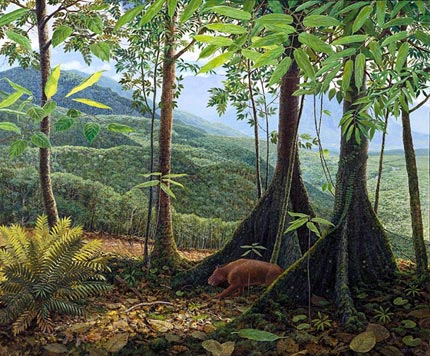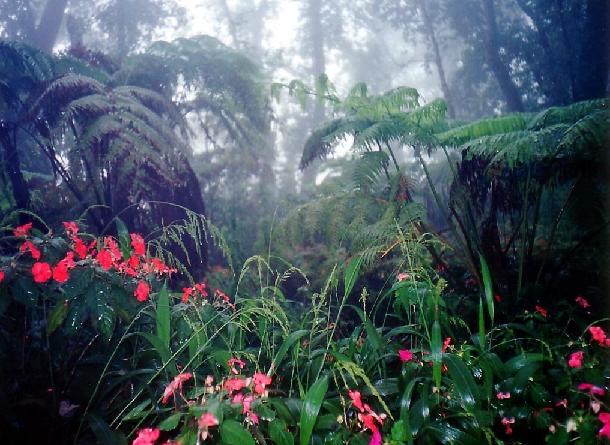![]()
El Origen de los Bosques Tropicales Modernos
En el Límite K-T, es decir tras la extinción de los dinosaurios, comenzaron a constituirse rápidamente los bosques neotropicales, es decir semejantes a los actuales. Con anterioridad al impacto del probable meteorito que acabó con aquellos gigantescos animales, la estructura y composición de estas formaciones boscosas calido-húmedas fue muy distinta de la actual, según se desprende de los análisis polínicos. Sin embargo, tras la enorme catástrofe surgieron, a gran velocidad, formaciones arbóreas tropicales-húmedas semejantes a las actuales, tanto en lo que respecta a su composición florística, como a la estructura de vuelo y suelo. La primera evidencia que da cuenta de estos ecosistemas se remonta al Paleoceno. Sin embargo, al parecer, atesoraban menos biodiversidad que los actuales.

El primer yacimiento de estas características analizado intensivamente, tras el límite K-T, se remonta a 58 millones de años atrás. Las condiciones climáticas eran más cálidas que las actuales en 3 y 5 º C., es decir entre 30 y 32 grados de media anual, y una pluviosidad superior a los 2,500 mm.
Sin embargo, los análisis realizados constatan una diferencia de consideración entre aquellos bosques tropicales “neo-primigenios” y los actuales. De acuerdo a la noticia, que abajo reproducimos de Sciencedaily, eran mucho menos biodiversos que los que podemos disfrutar hoy en día, en aquellos escasos lugares en donde el hombre no ha metido sus manazas. Los investigadores implicados, apuntan que los fósiles de las hojas muestran hojas dañadas que “sugieren” una herbivoría por parte de insectos generalistas, en lugar de las complejas y específicas relaciones que pueden observarse en nuestros tiempos, entre especies vegetales y especies más especialistas que viven en una estrecha interacción mutua.
Por tanto, todo parece apuntar a que, con el tiempo, aquellos “escasos” taxa generalistas, fueron sufriendo un proceso de especiación hacia otras formas más especializadas, fragmentando los nichos ecológicos, conforme aumentaba la biodiversidad de los ecosistemas. Se trata de un proceso lógico, al menos si nos atenemos a los conocimientos actuales.

Recreación del primer bosque del Eoceno. Fuente: The Resilient Earth
La nota de prensa acaba con la desiderata al uso sobre el cambio climático y bla, bla, que omito aquí, debido a que se trata de más de lo mismo: hipótesis muy generales en base a precarias evidencias empíricas.
Debe tenerse en cuenta que, como reconocen los investigadores implicados, se trata del primer yacimiento de esta naturaleza seriamente analizado con las tecnologías más novedosas. Así pues, serán necesarios estudios en otros lugares con vistas a averiguar si es posible que lo aquí descrito resulta ser un patrón general.
En otro post ya os informaremos sobre los primeros bosques tropicales ancestrales, es decir, previos al gran impacto meteorítico. Tiempo al tiempo, ya que hay que editar noticias para todos los gustos.
Juan José Ibáñez
First Neotropical Rainforest Was Home Of The Titanoboa — World’s Biggest Snake
ScienceDaily (Oct. 13, 2009) — Smithsonian researchers working in Colombia’s Cerrejón coal mine have unearthed the first megafossil evidence of a neotropical rainforest. Titanoboa, the world’s biggest snake, lived in this forest 58 million years ago at temperatures 3-5 C warmer than in rainforests today, indicating that rainforests flourished during warm periods.
«Modern neotropical rainforests, with their palms and spectacular flowering-plant diversity, seem to have come into existence in the Paleocene epoch, shortly after the extinction of the dinosaurs 65 million years ago,» said Carlos Jaramillo, staff scientist at the Smithsonian Tropical Research Institute. «Pollen evidence tells us that forests before the mass extinction were quite different from our fossil rainforest at Cerrejón. We find new plant families, large, smooth-margined leaves and a three-tiered structure of forest floor, understory shrubs and high canopy.»
Historically, good rock exposures and concentrated efforts by paleontologists to understand the evolution of neotropical rainforests—one of the most awe-inspiring assemblages of plant and animal life on the planet—have been lacking. «The Cerrejón mining operation is the first clear window we have to see back in time to the Paleocene, when the neotropical rainforest was first developing,» said Scott Wing, a paleontologist from the Smithsonian’s National Museum of Natural History.
Some of the more than 2,000 fossil leaves, including the compound leaves and pods of plants in the bean family and leaves of the hibiscus family are among the oldest, reliable evidence of these groups. This was the first time that the plant families Araceae, Arecaceae, Fabaceae, Lauraceae, Malvaceae and Menispermaceae, which are still among the most common neotropical rainforest families, all occurred together.
Many newcomers to modern rainforests remark that the leaves all look the same, a reasonable observation given that most have smooth margins and long «drip-tips» thought to prevent water from accumulating on the leaf surface.
S. Joseph Wright, senior scientist at STRI, has noted that all of the areas in the world today with average yearly temperatures greater than 28 C are too dry to support tropical rainforests. If tropical temperatures increase by 3 C by the end of this century as predicted in the 2007 report of the Intergovernmental Panel on Climate Change, «We’re going to have a novel climate where it is very hot and very wet. How tropical forest species will respond to this novel climate, we don’t know,» said Wright.
Based on leaf shape and the size of the cold-blooded Titanoboa, Cerrejón rainforest existed at temperatures up to 30-32 C and rainfall averages exceeded 2500 mm per year.
But Titanoboa’s rainforest was not as diverse as modern rainforests. Comparison of the diversity of this fossil flora to modern Amazon forest diversity and to the diversity of pollen from other Paleocene rainforests revealed that there are fewer species at Cerrejón than one would expect. Insect-feeding damage on leaves indicated that they could have been eaten by herbivores with a very general diet rather than insects specific to certain host plants.
«We were very surprised by the low plant diversity of this rainforest. Either we are looking at a new type of plant community that still hadn’t had time to diversify, or this forest was still recovering from the events that caused the mass extinction 65 million years ago,» said Wing. «Our next steps are to collect and analyze more sites of the same age from elsewhere in Colombia to see if the patterns at Cerrejón hold, and study additional sites that bracket the Cretaceous mass extinction, in order to really understand how the phenomenal interactions that typify modern rainforests came to be.»
This work is scheduled to be published online in the Proceedings of the National Academy of Sciences during the week of Oct. 12-16.
Adapted from materials provided by Smithsonian Tropical Research Institute, via EurekAlert!

[…] El Origen de los Bosques Tropicales Modernos http://www.madrimasd.org/blogs/universo/2010/04/15/135759 por pepevaz hace 3 segundos […]
Porque está en ingles? Nosotros lo queremos en español, como todo el resto de paginas.. xD.. xD
Hola, los hispano hablantes seriamos felices si este fuera el idioma dominante. Pero dicen los creyentes que dios no cumple antojos ni endereza jorobados. Hasta en las universidades alemanas existen cursos doctorales en la lengua del imperio. De momento y mientras no existan cambios socioeconómicos trascendentes, si queremos estar actualizados en el avance del conocimiento, tenemos que activar un poco mas nuestras neuronas. Dicen que esto saludable hasta para prevenir el Alzhaimer
no entiendo como que esten hablando sobre los bosques tropicales y no pongan que temperatura hace normalmente y si encima me lo ponen en ingles pues es la gota que colma el vaso. Si quieren hacer paginas como estas y que quieran informar a la gente, por favor, hacerlo bien porque no estareis haciendo nada. Gracias. Saludos.
Manolo,
En este blog escribimos post divulgativos para estudiantes y otros más complejos para los profesionales. Lamentablemente tu necesitabas una información más basica y toda en español y has encontrado otra. Pero no juzgues prematuramente, hay escritos 1200 post para todas las edades y públicos.
Es nuestra obligación.
Saludos
Juanjo Ibáñez
M AYUDO MUCHO GRACIAS MEUCHS GRACIAS